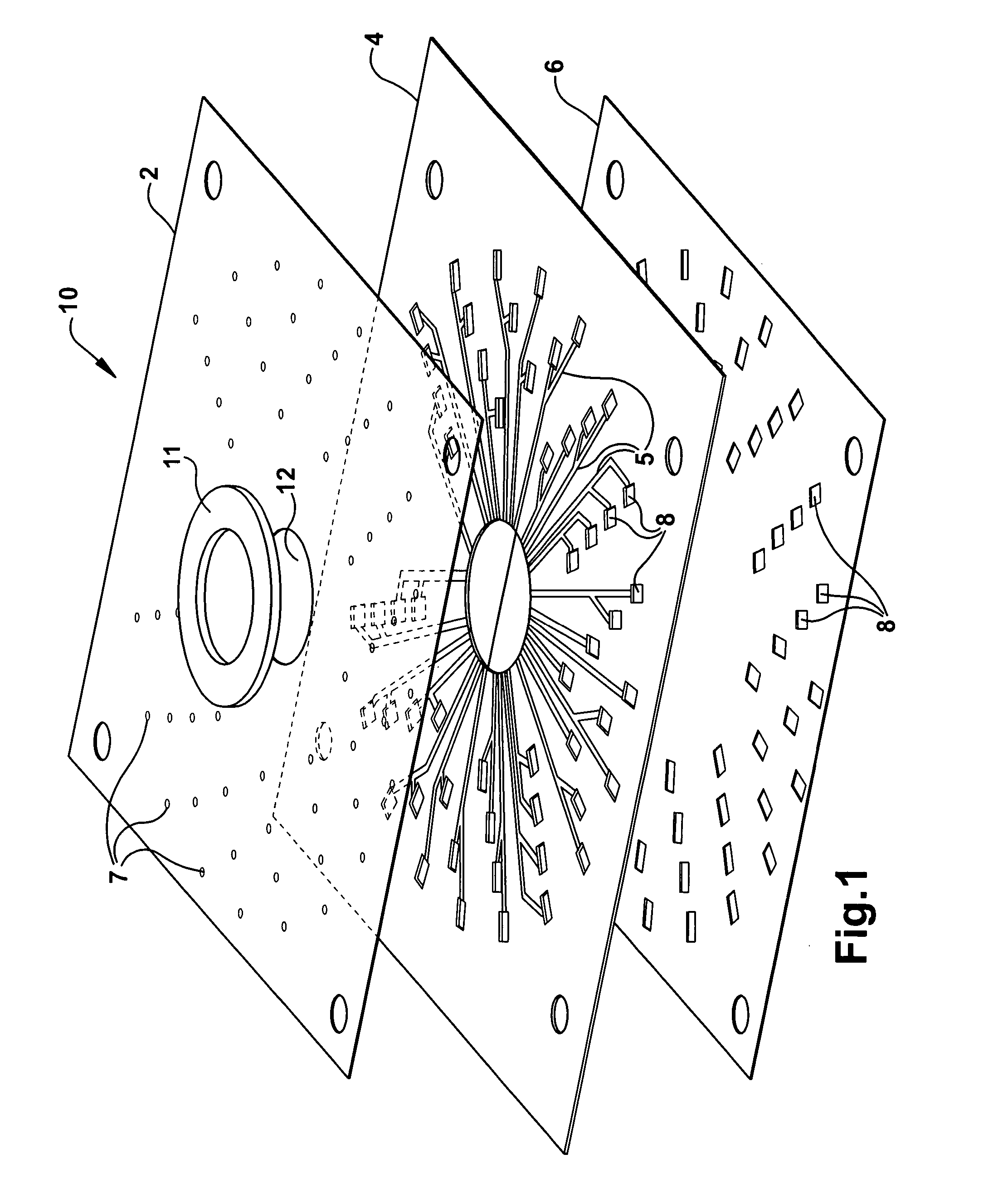Methods and systems for delivery of fluidic samples to sensor arrays
- Summary
- Abstract
- Description
- Claims
- Application Information
AI Technical Summary
Benefits of technology
Problems solved by technology
Method used
Image
Examples
example 1
[0107] Reservoir fill time as a function of channel and reservoir geometric parameters. The channel and reservoir layout are shown in FIG. 20. The device comprises three layers as shown similarly in FIG. 1. The top cover layer 2 is a heat sealable hydrophilic film. Vent holes 7 (1.5 mm diameter) were cut through this layer. The middle channel layer 4 is a 0.78 mm thick polycarbonate sheet with open channels 5 and rectangle openings (i.e., reservoirs) 8 cut by means of computer numerical controlled (CNC) machining. The bottom sampler binding layer 6 is a 40 Shore A silicone gasket, providing seal to a substrate. Rectangle openings are die cut through the gasket. When these layers are laminated to form a fluid delivery device, channels are created between the top hydrophilic layer 2 and middle channel layer 4. The rectangle openings of the channel layer and sampler binding layer define an open-bottom reservoir, with the hydrophilic layer as its top wall. When this assembly is attached...
example 2
[0111] A 54-reservoir sample delivery device is shown in FIG. 1. The device 10 is assembled from four components by a method similar to that described in Example 1. The channel 5 depth and width are 0.33 mm and 1.5 mm, respectively. The length and width of reservoirs 8 are 5.5 and 4 mm, respectively. The sampler binding layer 6 is cut from a 0.55 mm thick, adhesive backed, and transparent silicone rubber sheet. The thickness of the polycarbonate channel layer 4 is 0.78 mm. Selection of these design parameters was guided by the equation shown in Example 1. A 2.7 ml sample solution containing 100 ppm Basic Blue was delivered to the sample entry port. Real time flow in the channels and reservoirs were monitored using a digital video camera. Fill time for each reservoir was retrieved from the recorded video films. Average fill times for all 54 reservoirs obtained from six devices are presented in FIG. 22. The data demonstrate that the device allows delivering a liquid sample to multiple...
example 3
Determination of Chlorine Concentration in a Water Sample
[0112] Six chlorine sensitive films were deposited on a thin translucent polyethylene sheet. A 20 μl chlorine standard solution, prepared from a 5% NaOCl by dilution with deionized water, was spotted on each film. The water sample was removed from the films 1 minute after spotting. A blue color was developed as chlorine in the water sample reacts with the chlorine sensitive reagent immobilized in the films. The image of these six films was captured with Hewlett Packard scanner ScanJet 6300C and is shown in FIG. 5. The digital file produced from the scanner was in the JPEG format (67 KB). The color depth was 255. The pixel resolution is 200 dpi.
[0113] The digital image was processed with Adobe Photoshop® 6. The film areas were selected using the selection tools provided by the Photoshop software package. Average RGB values for each selected color area are listed in Table 2 below. RGB values for the white paper area of the ima...
PUM
| Property | Measurement | Unit |
|---|---|---|
| Temperature | aaaaa | aaaaa |
| Temperature | aaaaa | aaaaa |
| Mass | aaaaa | aaaaa |
Abstract
Description
Claims
Application Information
 Login to View More
Login to View More - R&D
- Intellectual Property
- Life Sciences
- Materials
- Tech Scout
- Unparalleled Data Quality
- Higher Quality Content
- 60% Fewer Hallucinations
Browse by: Latest US Patents, China's latest patents, Technical Efficacy Thesaurus, Application Domain, Technology Topic, Popular Technical Reports.
© 2025 PatSnap. All rights reserved.Legal|Privacy policy|Modern Slavery Act Transparency Statement|Sitemap|About US| Contact US: help@patsnap.com



